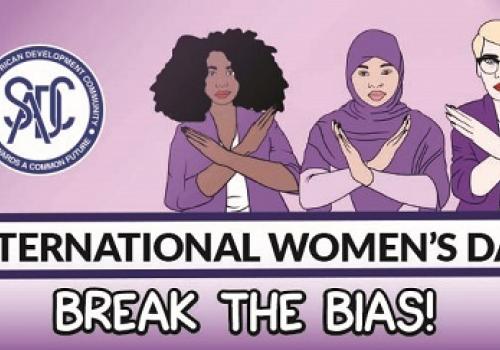This year’s International Women’s Day, which falls on 8th March every year, recognises the existence of gender inequalities and makes an unequivocal call to action for accelerating women’s equality through a campaign theme; “breaking gender bias and reducing stereotypes and discrimination to promote diversity, equity, and inclusion”, which is being promoted under the hashtag #BreakTheBias.
The Southern African Development Community (SADC) joins the international community in this campaign to #BreakTheBias, recognising that each day, women battle harmful stereotypes that affect their careers, health, wellbeing, lifestyles, relationships, education, and so much more. The #BreakTheBias campaign seeks to address societal norms, unjust laws, and missing human rights which pose a challenge to equality for women and girls around the world.
The level of gender inequalities and the plight of women in the SADC Region are well documented. The 2018 SADC Gender and Development Monitor indicated that, in many parts of the region, women still face unequal access to decisions-making, formal financial systems, land ownership, reproductive health care and education and information, undermining their well-being in addition to that of their families and communities. Data available also indicates that women in the SADC region represent the majority of the poorest and the most vulnerable among social groups, due to the general subordinate legal status, limited access to productive resources such as land, technology, credit, education and training, formal employment, as well as susceptibility to HIV and AIDS. Additionally, women continue to be disadvantaged by limited access to and control over productive resources despite positive developments in the review of laws on access to some of these. Recently, inequality has been exacerbated by the COVID19 pandemic.
In the face of climate change, which threatens to set back development efforts in the region, women continue to feel its disproportionate impacts, through increased difficulties in accessing water and agriculture activity practices, areas that are dominated by women. In addition, climate change related disasters, including desertification, droughts and floods, which sometimes displace people, affect mainly women and children, including exposing them to sex abuse.
While women are vulnerable to climate change and disasters, they are also an untapped resource in our collective efforts to cope with climate change and reduce the emissions that cause it. We must, therefore, incorporate a gender perspective into climate change policies, projects and funds to ensure that women contribute to and benefit from equitable climate solutions. Women must take leadership and stewardship in the areas of natural resource management and environmental conservation, the water-food-climate nexus, livelihoods and relevant social and physical infrastructural support, sexual and reproductive health and rights, girls’ education as well as other relevant dimensions such as data collection, youth engagement and grassroots solutions for climate change and disaster risk reduction. Women must also take an active part in the response measures to climate change adaptation, mitigation, technology, capacity building and financing.
This International Day of Women, must serve as a reminder to all stakeholders to use every tool at our disposal, including using a plethora of legal and policy instruments and programmes that cover all the dimensions of Gender equality for sustainability. Key among the instruments are the Regional Indicative Strategic Development Plan (RISDP2020-2030) and SADC Vision 2050, which do not only identify gender as an important cross cutting issue but also recognise gender equality and women’s empowerment as important enablers of regional integration. Through the implementation of the RISDP 2020-2030, we are geared to strengthen gender mainstreaming mechanisms and technical capacity at both national and regional levels to address gender-based violence (GBV), promote representation and participation of women in politics and decision-making, and strengthen meaningful women’s economic empowerment.
I call on all stakeholders to accelerate the implementation of the different frameworks on climate change and disaster management which include, among others, the SADC Protocol of Environmental Management for Sustainable Development, the revised SADC Regional Climate Change Strategy and Action Plan 2021; the SADC Biodiversity Strategy and Action of 2015; the SADC Green Growth Strategy, 2015; and the SADC Sub-Regional Action Plan (SRAP) to combat desertification, which includes the implementation of the Great Green Wall Initiative. In implementing these policy instruments, all efforts must be made to put women and girls at the centre, guided by the overarching SADC development frameworks of the RISDP2020-2030 and SADC Vision 2050.
I urge all stakeholders to take into account the intersectionality of gender equality, climate change, environment, and disaster risk reduction and management in the implementation of development programmes. It is our collective duty to break gender biases and reduce stereotypes and discrimination to promote diversity, equity and inclusion in the SADC region. We can #BreakTheBias and, ultimately, achieve Sustainable Development Goal (SDG) 5 on achieving gender equality and empowering all women and girls, if we work together in unity.

